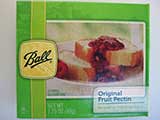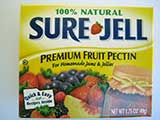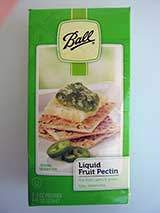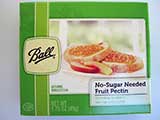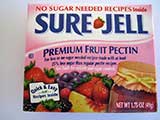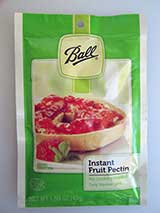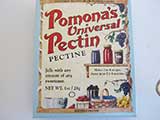Meats and Sausages
Pectin
Pectin occurs in varying accounts in all plants and fruits. It is not found in animal tissues. The skins, cores, and peels are a particularly rich source of pectin. During ripening, those substances convert naturally to pectin, but this conversion can be forced by long cooking, as in traditional methods of making jellies. It is necessary to cook the fruit to extract the pectin. Jams and jellies have been produced for many years, and through experience our grandmothers knew that products made from apple, currant, and quince, turned out better than those made from other fruits. They stood over a hot, boiling pot, patiently stirring fruits until they cooked them down to a thicker consistency. Today, this process can be shortened by adding powdered pectin. What they did not know that those fruits were very rich in gelling pectin. They mixed pectin rich fruits or fruit extracts with fruits which do not set jams well, for example strawberry with gooseberry or with red currant. Extracts of apple peels and cores were also used for "difficult to set" jams.
Pectin was first isolated in the 1820s, and shown to be the key to making jams and jellies. Commercial jam producers sought further supplies of pectin source materials. In Germany, apple juice producers started to dry the pomace residue left after pressing juice for sale to jam makers, who would cook the pomace in water with or without fruit juice to make a jellying juice. The first commercial production of a liquid pectin extract was recorded in 1908 in Germany, and from that time on there was rapid growth in the pectin industry in the United States and in Europe, followed recently by Brazil and Mexico.
It should be noted that it is impossible to make totally sugarless jam or jelly even with low sugar/no sugar pectin. The jam will gel fine, sugar substitutes will provide sweetness, but fruit contains its own natural sugar, which will remain. Nevertheless, such products are the answer to diabetics and people on low calorie diets. The flavor of those products may not be exactly the same, but it comes pretty close.
Pectin occurs in fruit in three forms:
- Protopectin - hard immature fruits like green apples or the peel of citrus fruits.
- Pectin - as the fruit matures protopectin becomes a soluble pectin, which is used in making jelly.
- Pectin acid - if fruit becomes over-ripe or a jelly is cooked too long, the pectin converts to pectic acid.
The amount of pectin in fruit is rather small. Under ripe fruit contains more pectin than mature fruit but lacks the fully developed flavor. Only few fruits contain enough pectin and acid to produce quality jelly by cooking alone. Most fruit juices are very low in pectin. During jelly production we usually add in extra pectin. This extra pectin is in a form of tasteless powder which is commercially produced by extracting pectin from citrus fruit or apples. Pectin is graded according to its jellifying strength and is used for making jams, jellies, marmalades and preserves. Powdered pectin does not easily dissolve in solutions which contain more than 25% sugar and it is best to dissolve pectin first in water, or natural juice.
Pectin is a gelling agent. It creates bonds with water (pectin-water) and with itself (pectin-pectin). Pectin-pectin bond gives the gel the strength and pectin-water bond gives jelly its softness. A different proportion between those two types of bonds give jam or jelly a different texture.
Pectin is one of the most versatile stabilizers available. Its gelling, thickening and stabilizing attributes makes it an essential additive not only in jams and jellies but in the production of many other food products, as well as in pharmaceutical and medical applications. The FDA recognizes pectin as GRAS (generally recognized as safe). It may be used in all non-standardized foods.
This wide range of applications explains the need for many different types of commercial pectins, which display different gelation characteristics and are sold according to their application, for example:
Rapid set pectin - traditionally used for jams and marmalades (pH 3.0-3.4)
Slow set pectin - used for jellies and for some jams and preserves, especially using vacuum cooking at lower temperatures. Also important for higher sugar products like bakery and biscuit jams, sugar confectionery, etc. (pH 2.8-3.2)
Low methyl ester and amidated pectins - used in a wide range of lower sugar products, reduced sugar preserves, fruit preparations for yogurts, dessert gels and toppings, and savory applications such as sauces and marinades. Can also be used in low acid high sugar products such as preserves containing low acid fruits (figs, bananas) and confectionery. Low methoxyl pectin (LMP) can gel at higher pH levels and has lower sugar requirements so it is of special interest to people on low calorie diets. It is also used as a fat replacer in meat, poultry, and fish products as well as in making low fat sausages.
Stabilizing pectins - used for stabilizing acidic protein products such as yogurts, whey and soya drinks against heat processing. Pectins can stop the milk protein in yogurt from curdling with heat, so heat treated long life yogurt drinks can be made.
Pectin is available from online suppliers, in health food stores and in local supermarkets. The grading system is based on the parts of sugar (water also present) that will be gelled by one part of pectin. For example, one part of 100 grade pectin gels 100 parts of sugar. One part of 150 grade pectin will gel 150 parts of sugar.
Many types of commercial pectin are available:
Regular cooked jellies and jams. Available in powder or liquid.
Advantages of commercial pectin
Commercially prepared pectin is a natural and safe product. It is an extract from apples or citrus fruits and being tasteless it doesn't change the flavor. It just helps thicken, and offers many advantages:
Drastically shortens cooking time. This results in more product as there is lesser amount of evaporated water. These two advantages greatly offset the initial cost of pectin. Allows for making jellied products from fruits that are pectin poor. Juice from such fruits will not produce jelly, unless a commercial pectin is added. The final product displays a much lighter color as due to a shorter cooking process, there is no time for sugar to caramelize. Some pectins allow for using a small amount to no sugar.
The disadvantage of commercial pectin, at least for home production, is that each brand of pectin contains its own proprietary instructions and recipes for making jellied products. This locks a customer to a particular brand of pectin and many home jam makers don't know how to make jellied products without added pectin anymore.

